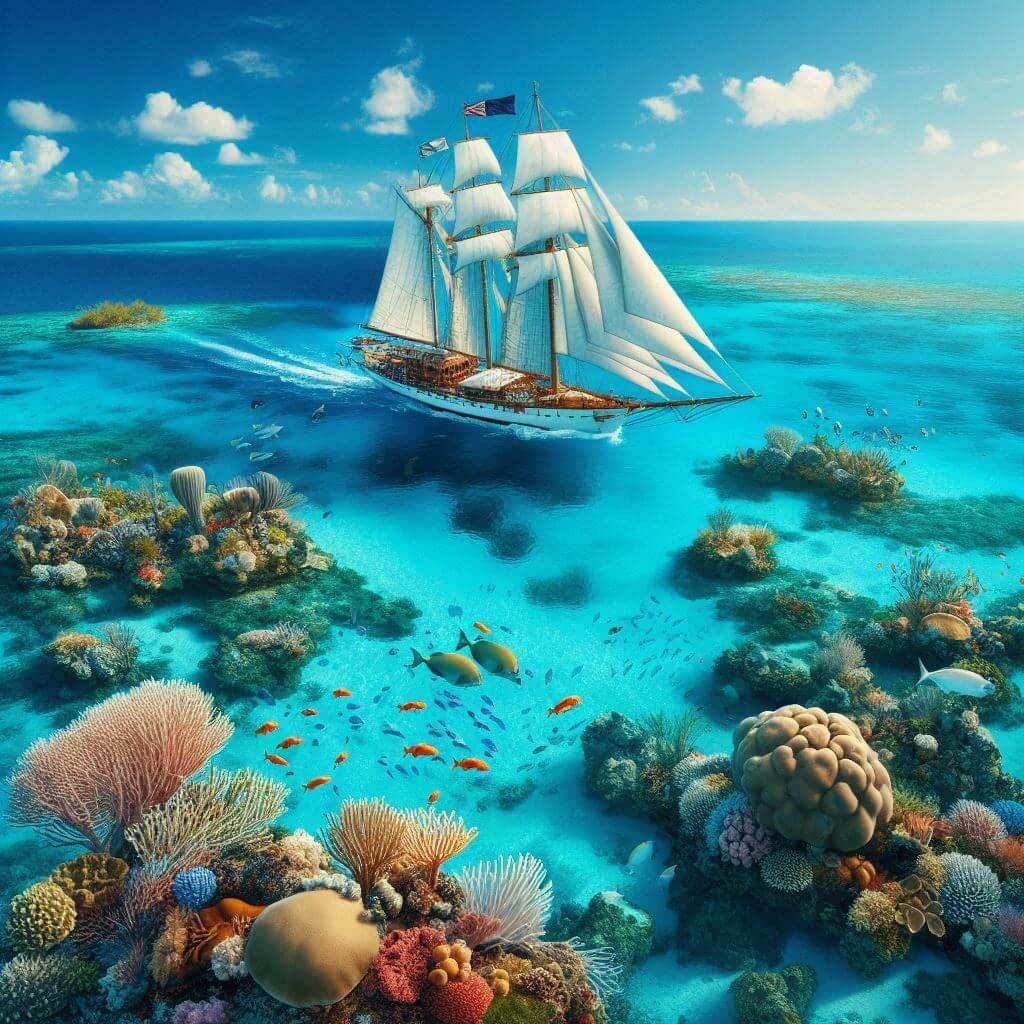La bandera de las Bahamas consiste en tres bandas horizontales de color aguamarina, dorado y aguamarina, con un triángulo equilátero negro basado en el lado del asta. Este diseño distintivo captura la esencia de la belleza natural, el patrimonio cultural y la identidad nacional de las Bahamas.
Información sobre las Bahamas
| Día Nacional de la Bandera | 10 de julio |
| Estado soberano | Sí |
| Nombre oficial | La Mancomunidad de las Bahamas |
| Capital | Nassau |
| Población | 393,008 |
| Área | 13,880 km² |
| Moneda | Dólar bahameño (BSD) |
| Idioma | Inglés |
| Continente | América del Norte |
| Región | Caribe |
| Subregión | — |
| Fronteras | Las Bahamas es un archipiélago y no comparte fronteras terrestres con ningún país |
| Zona horaria | Hora Estándar del Este (EST) UTC-5 |
| Código de llamada | +1 242 |
| Dominio de nivel superior | .bs |
Historia de la bandera de las Bahamas
 La bandera fue adoptada oficialmente el 10 de julio de 1973, coincidiendo con la independencia de las Bahamas del Reino Unido. Su creación fue el resultado de un concurso nacional, reflejando el espíritu democrático de la nación recién independiente. El Dr. Hervis L. Bain Jr., un artista y diseñador gráfico local, presentó el diseño ganador, que fue elegido entre más de 1,000 entradas.
La bandera fue adoptada oficialmente el 10 de julio de 1973, coincidiendo con la independencia de las Bahamas del Reino Unido. Su creación fue el resultado de un concurso nacional, reflejando el espíritu democrático de la nación recién independiente. El Dr. Hervis L. Bain Jr., un artista y diseñador gráfico local, presentó el diseño ganador, que fue elegido entre más de 1,000 entradas.
Antes de la independencia, las Bahamas usaban el Pabellón Azul Británico con la insignia de la colonia. La transición a la bandera actual marcó un momento significativo en la historia de las Bahamas, simbolizando la emergencia del país como una nación soberana y su ruptura con el dominio colonial.
Simbolismo y diseño de la bandera de las Bahamas
Cada elemento de la bandera de las Bahamas tiene un significado profundo:
- Las bandas aguamarina representan el Mar Caribe y el Océano Atlántico, que rodean el archipiélago y juegan un papel crucial en la vida, cultura y economía de las Bahamas.
- La banda dorada simboliza las playas arenosas de las islas, así como el sol que atrae a los turistas y apoya la vital industria turística de la nación.
- El triángulo equilátero negro representa la unidad y determinación del pueblo bahameño. Su forma apuntando hacia el lado del asta significa el movimiento y progreso hacia adelante de la nación.
Los colores de la bandera también fueron elegidos para reflejar la membresía de las Bahamas en la Mancomunidad de Naciones, con el negro, dorado y azul siendo colores prominentes en los escudos de armas de muchos países de la Mancomunidad.
Uso y significado de la bandera de las Bahamas
 La bandera de las Bahamas es un poderoso símbolo de orgullo nacional, unidad e independencia. Se exhibe prominentemente en edificios gubernamentales, escuelas e instituciones públicas en todo el archipiélago. Durante los días festivos nacionales, particularmente el Día de la Independencia el 10 de julio, la bandera ocupa un lugar central en las celebraciones en todo el país.
La bandera de las Bahamas es un poderoso símbolo de orgullo nacional, unidad e independencia. Se exhibe prominentemente en edificios gubernamentales, escuelas e instituciones públicas en todo el archipiélago. Durante los días festivos nacionales, particularmente el Día de la Independencia el 10 de julio, la bandera ocupa un lugar central en las celebraciones en todo el país.
En contextos internacionales, la bandera de las Bahamas representa a la nación en eventos diplomáticos, reuniones de las Naciones Unidas y competiciones deportivas globales. Sirve como un embajador visual, instantáneamente reconocible y respetado en todo el mundo, encarnando la soberanía de las Bahamas y su lugar en el escenario global.
Datos interesantes sobre la bandera de las Bahamas
- El diseño de la bandera fue elegido a través de un concurso nacional, enfatizando el proceso democrático de su adopción y la participación de los ciudadanos bahameños en la formación de sus símbolos nacionales.
- El tono específico de azul utilizado en la bandera a menudo se refiere como "aguamarina" o "azul Nassau", reflejando el color único de las aguas que rodean las Bahamas.
- Las proporciones de la bandera son 1:2, lo que significa que su ancho es la mitad de su longitud, una proporción común para las banderas de las antiguas colonias británicas.
- El Escudo de Armas de las Bahamas, que incluye elementos similares a los de la bandera, fue otorgado por el Colegio de Armas Británico en 1971, dos años antes de la independencia.
- La bandera a veces se refiere como "La Gloria" por los bahameños, destacando su importancia como símbolo de orgullo nacional.
- Durante la ceremonia de izado de la bandera en la independencia en 1973, la Union Jack británica se bajó por última vez, y se izó la nueva bandera bahameña, marcando un momento histórico en la historia de la nación.





